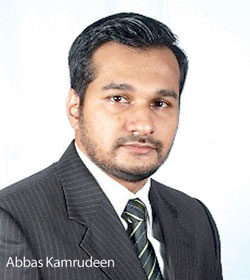FITIS Software Chapter President defines ambitious plans for industry
14 May 2015 06:46 am Views - 1544
“At present, Sri Lanka’s earnings from the export of softw

“In order to achieve this new, enhanced target, we have to make a series of significant changes for the forward-march and overall progress of Sri Lanka’s software industry. We have worked out a comprehensive plan of action to make this initiative a reality”, Abbas Kamrudeen stressed.
The key objectives under focus are increased import substitution through enhancement and development of locally developed software products and services and extending assistance to members to initiate and increase software exports in order to meet the national target of IT/BPO industry, as the highest net foreign income generating industry in Sri Lanka.
The focus is on four salient pillars to achieve these objectives attracting human capital to the industry, increasing the quality and efficiency of human capital through training and development, business development activities for members and Canvassing/Addressing policy decisions necessary to develop the industry, he said.
Some of the new initiatives lined up for this year include an incubation centre to assist local software vendors to move towards export-oriented business advisory services would cover, international market information, market penetration strategies, identifying and selecting partners, communication training, collateral preparation, product customization, localization requirements, mentoring, etc.
“As members of regional ICT bodies such as ASOCIO and APICTA, we plan to carry out extensive business match-making events between local companies and counterparts in other countries to promote local software internationally”, Abbas Kamrudeen noted.
“We will also be studying the feasibility of setting up a software product testing and certification facility. This would allow clients to make informed decisions and vendors to differentiate themselves”, he said.
He said that many other ideas are under discussion and they encompass initiating escrow facilities for finance and intellectual property. These facilities are not readily available in Sri Lanka mainly because of the complexities involved.
This facility would allow payments for software solutions to be held in escrow and disbursed on basis such as project progress or functional deliverables. Source code can also be held in escrow to give clients peace of mind that their software investment is protected irrespective of the vendors’ continuity, the Association’s president noted.
“We are also looking at setting up a Dispute Resolution Centre to hear software related disputes. This would allow peace of mind for both local and international clients who shy away from legal proceedings due to the complex nature of the industry and its practices”, Kamrudeen emphasized.
Plans are also underway to establish a separate dedicated center to facilitate the purchase of software products by potential local buyers. This center will feature a collection of software products developed by member associations. This will give a wide and varied choice to potential buyers, he elaborated.
In terms of the plan of action to emerge victorious in the global marketplace, Sri Lankan developers will be afforded the opportunity of accessing information relating to the international market, map out strategies to venture into the market and identify and select the right buyers. They will also be provided with training on communications, facilities to stabilize their products and offered advisory assistance.